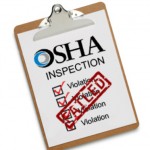Learn More About How To Manage Safety Training
Most small Texas manufacturing and construction companies struggle with understanding and managing OSHA training requirements, however failing to do so puts employees at risk for serious injuries and even fatalities, and the company at risk for huge fines and penalties. Just because a company is small and under resourced is no excuse and they have the same requirements as large companies.
Here’s a quick summary of basic OSHA training and standard requirements:
- In summary, each OSHA Standard has a corresponding training requirement. For example, the Fall Protection Standard includes a training requirement that must address all fall hazards at a particular company.
- Common topics include Hazard Communication (Chemical Safety), Personal Protective Equipment, Emergency Response & Fire Prevention, Lockout/Tagout, Electrical Safety, Confined Spaces, Respiratory Protection, Hearing Conservation, and the list goes on.
- The number of Standards that must be trained depends on that manufacturer’s processes & hazards, but it’s common for a company to be required to train between 8-12 topics per year to each of its employees.
- Training topics should be matched with employee responsibilities and exposure to particular hazards. In other words, all employees don’t necessarily need to be trained on all topics, only those topics that impact their scope of work.
- Each topic typically takes a minimum of 30 minutes to train, but most take between 45-60 minutes in order to address adequately, and some topics take longer.
- Training session should be delivered by an experienced and qualified trainer who has the technical knowledge and expertise to train the topic. Not only does this ensure that all aspects of each topic are trained, but it also ensures that the trainer is able to address questions from the audience.
Ideally the trainer also has an “approachable” personality who can invite participation and engage the audience. Nobody wants to be trained by a “robot” or unqualified person, it’s a waste of time for everyone involved.
Some companies opt to utilize an “on-line” training resources or videos. This is acceptable, however it prevents the possibility for employees to ask and receive answers to their questions. They are very generic and may not touch on your specific hazards. OSHA has a standard requiring that employees “must understand and be able to use their training,” but if they’re unable to ask questions, and get answers, then frequently this standard is not met.
- Some standards require both written and/or performance evaluations. This is especially true with forklift and crane operator training.
- Some OSHA standard training requirements are “one-time,” but many are recurring and are mandated to occur each year. Even those that aren’t mandated to occur annually are always “recommended” by OSHA to occur each year and employers who take health and safety seriously should do so.
- Employers must create and maintain training records, because as far as OSHA is concerned, “if there isn’t a record, then it didn’t occur.” It’s recommended that companies create a Sign-In sheet for each training session, which includes the topic trained, the instructor’s name, and then has lines for each employee’s printed name (legible), signature and date. Always keep a copy of the training record on file.
- Many of these training topics should be included in your New Hire Orientation program. Especially Hazard Communications, specific personal protective equipment, Emergency Action & Fire Prevention Plan. Companies with historically low accident rates have an effective task training program that pays particular attention to task hazards and safety.
- Be aware of those “Experienced” new hires. Do not assume that experienced employees were trained properly (remember that you need training records to prove this), and less desirable new employees may bring their bad safety habits into your company.
As mentioned before, it’s tough enough for an employer to get their existing employee roster trained once on all topics, but the problem is compounded by turnover issues, and then having to constantly train new employees throughout the year. As a result, most manufacturers find that training literally becomes a “never ending project.”
Another common mistake/misconception regarding training: Many employers make the mistake of believing that occasional (weekly or monthly) 15 minute “tailgate” training sessions meet all OSHA safety training requirements. These short sessions are typically designed to address a single hazard, or aspect of a hazard and their overall purpose is to help “keep safety top of mind” and maintain or build the culture of safety in a company. These short training sessions are a great management tool and useful to reinforce general safety training or a specific topic, but they don’t meet the formal OSHA standard training requirements and therefore should not be considered a substitute for those requirements.
Learn more about OSHA compliance requirements here.
Worried About Your Company’s OSHA Compliance Condition & Where You Stand?
It’s Time For A Checkup!
SCHEDULE YOUR FREE CONSULTATION TODAY

